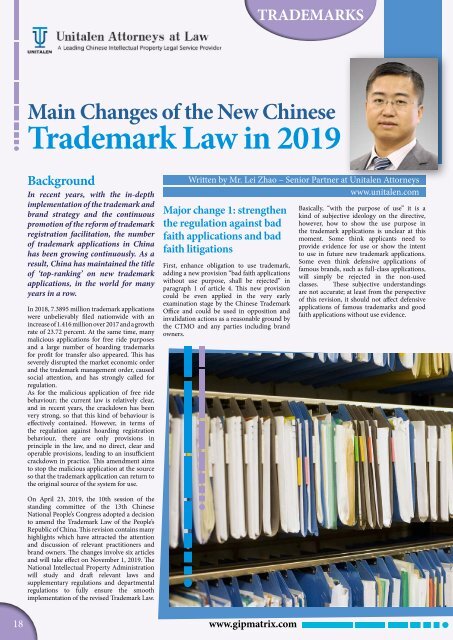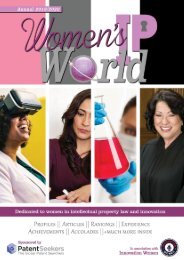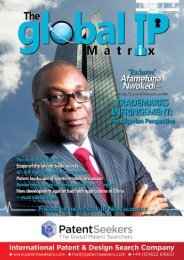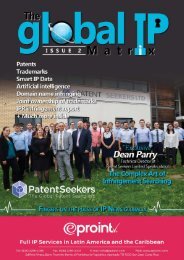Global IP Matrix - Issue 5
It has been a fantastic year for The Global IP Matrix magazine, thanks to all the efforts made by our contributors and to you, the reader for your continued support. We take great pleasure in putting together each issue of this publication, and we sincerely hope you enjoy this final issue of 2019. We have again, collaborated with some of the world's most influential IP law firms and businesses to bring you another eclectic mix of content, direct from the professionals working at ground level. We are already excited for the coming year and cannot wait to continue growing and evolving in our partnerships to bring you some exciting new features for 2020. Ms. Elvin Hassan Editor & Head of international liaisons
It has been a fantastic year for The Global IP Matrix magazine, thanks to all the efforts made by our contributors and to you, the reader for your continued support. We take great pleasure in putting together each issue of this publication, and we sincerely hope you enjoy this final issue of 2019. We have again, collaborated with some of the world's most influential IP law firms and businesses to bring you another eclectic mix of content, direct from the professionals working at ground level. We are already excited for the coming year and cannot wait to continue growing and evolving in our partnerships to bring you some exciting new features for 2020.
Ms. Elvin Hassan
Editor & Head of international liaisons
You also want an ePaper? Increase the reach of your titles
YUMPU automatically turns print PDFs into web optimized ePapers that Google loves.
TRADEMARKS<br />
Main Changes of the New Chinese<br />
Trademark Law in 2019<br />
Background<br />
In recent years, with the in-depth<br />
implementation of the trademark and<br />
brand strategy and the continuous<br />
promotion of the reform of trademark<br />
registration facilitation, the number<br />
of trademark applications in China<br />
has been growing continuously. As a<br />
result, China has maintained the title<br />
of ‘top-ranking’ on new trademark<br />
applications, in the world for many<br />
years in a row.<br />
In 2018, 7.3895 million trademark applications<br />
were unbelievably filed nationwide with an<br />
increase of 1.416 million over 2017 and a growth<br />
rate of 23.72 percent. At the same time, many<br />
malicious applications for free ride purposes<br />
and a large number of hoarding trademarks<br />
for profit for transfer also appeared. This has<br />
severely disrupted the market economic order<br />
and the trademark management order, caused<br />
social attention, and has strongly called for<br />
regulation.<br />
As for the malicious application of free ride<br />
behaviour; the current law is relatively clear,<br />
and in recent years, the crackdown has been<br />
very strong, so that this kind of behaviour is<br />
effectively contained. However, in terms of<br />
the regulation against hoarding registration<br />
behaviour, there are only provisions in<br />
principle in the law, and no direct, clear and<br />
operable provisions, leading to an insufficient<br />
crackdown in practice. This amendment aims<br />
to stop the malicious application at the source<br />
so that the trademark application can return to<br />
the original source of the system for use.<br />
Written by Mr. Lei Zhao – Senior Partner at Unitalen Attorneys<br />
www.unitalen.com<br />
Major change 1: strengthen<br />
the regulation against bad<br />
faith applications and bad<br />
faith litigations<br />
First, enhance obligation to use trademark,<br />
adding a new provision “bad faith applications<br />
without use purpose, shall be rejected” in<br />
paragraph 1 of article 4. This new provision<br />
could be even applied in the very early<br />
examination stage by the Chinese Trademark<br />
Office and could be used in opposition and<br />
invalidation actions as a reasonable ground by<br />
the CTMO and any parties including brand<br />
owners.<br />
Basically, “with the purpose of use” it is a<br />
kind of subjective ideology on the directive,<br />
however, how to show the use purpose in<br />
the trademark applications is unclear at this<br />
moment. Some think applicants need to<br />
provide evidence for use or show the intent<br />
to use in future new trademark applications.<br />
Some even think defensive applications of<br />
famous brands, such as full-class applications,<br />
will simply be rejected in the non-used<br />
classes. These subjective understandings<br />
are not accurate; at least from the perspective<br />
of this revision, it should not affect defensive<br />
applications of famous trademarks and good<br />
faith applications without use evidence.<br />
On April 23, 2019, the 10th session of the<br />
standing committee of the 13th Chinese<br />
National People’s Congress adopted a decision<br />
to amend the Trademark Law of the People’s<br />
Republic of China. This revision contains many<br />
highlights which have attracted the attention<br />
and discussion of relevant practitioners and<br />
brand owners. The changes involve six articles<br />
and will take effect on November 1, 2019. The<br />
National Intellectual Property Administration<br />
will study and draft relevant laws and<br />
supplementary regulations and departmental<br />
regulations to fully ensure the smooth<br />
implementation of the revised Trademark Law.<br />
18 www.gipmatrix.com












